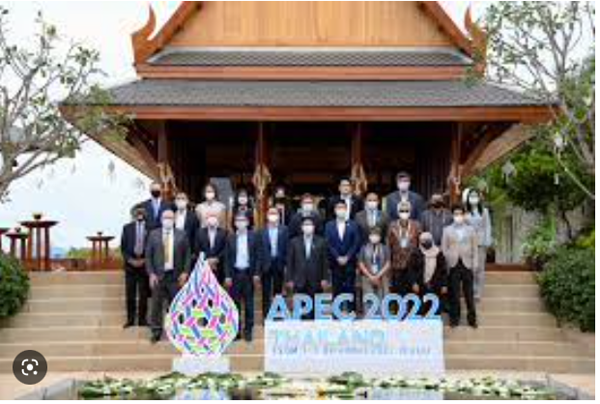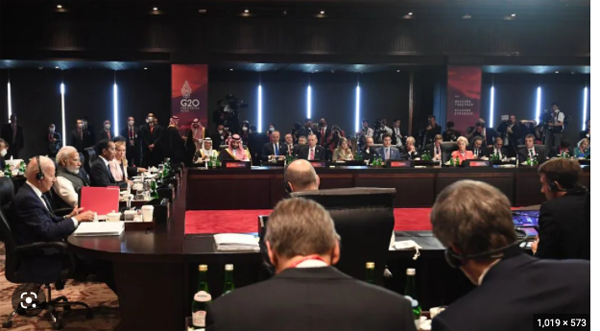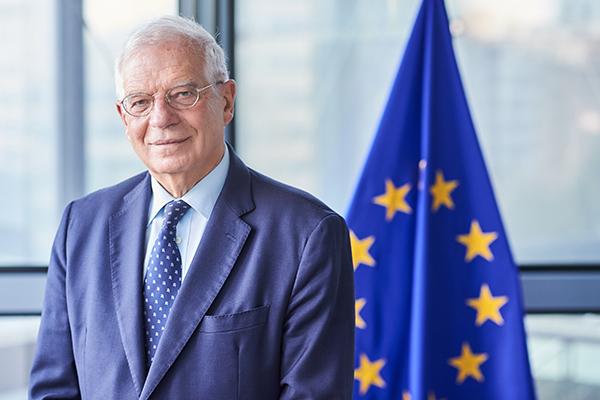Mehri Madarshahi: A new dawn for multilateralism We are better together
December 02 , 2022By Mehri Madarshahi, CCG Non-Resident Senior Fellow, Advisory Member of the UNESCO International Centre for Creativity and Sustainable Development .
In recent years, there are not many weeks in which so many worthwhile events globally and regionally have taken place at the same time. The week of 12-19 November was one such when the world at long last decided to cherish and revisit the important but almost forgotten notion of multilateralism.
This period included the release of most results of the mid-term elections in the US when all 435 seats of the House of Representatives and 35 of 100 seats in Senate were up for grabs. Predictions by pollsters and press pundits erroneously forecast an overwhelming red, i.e., Republican wave across the US and a loss of both chambers hitherto led by the Democrats. The ripple effect of these elections and their results could well have changed the future course of actions by the US Government actions and could have also impacted negatively various ongoing discussions and agreements pursued by the US world-wide. A complete control of the US Congress by Republicans, upholding the mantel of Donald Trump, might well have translated at the national level, to further tax cuts for the rich and mega-companies, reversing Prosperity Act, attack on Obamacare, employment, covid recovery and infrastructure packages devised by the Biden Administration and enacted by Congress. At the global level, it might have ushered in an immediate change of course regarding the war in Ukraine, a weakening of a rejuvenated NATO, disturbing the fragile bind between Europe and the US on global issues, weakening national and international support for climate change action (Where all NEW FUNDINGS must be voted upon and approved) and imposing ever more rigid positions on various foreign policy issues.
To the relief of many, the feared red Republican wave turned into sizeable blue Democrat gains in many places resulting in the continued control of Senate by the Democrats and just a razor-thin majority of Republicans in the House. Many Governorships across the country were also captured unexpectedly by the Democrats. Analysts concluded that the results of these mid-term elections, will have wide-ranging consequences, from Congress to presidential politics to international activities.
Overall, the US electorate delivered a warning against extremists and ultra-rights leanings. Nevertheless, the votes will translate likely into a messy, partisan two years, with open questions about who will even be in 2024 on the Presidential ballot for each party. Most observers anticipate a political stalemate on most issues and a lack of progress for the second half of Biden’s presidency.
Th exciting developments of the US elections partly overshadowed various global and regional crisis such as the Iranian revolt and unrests driven by women and youth, soaring inflation across the global economy, downward moves of the British economy, climate emergencies and a looming energy crisis in Europe.
COP27 (SHARM EL SHEIKH, 7-18 NOVEMBER)

During the same week, the highly anticipated meeting of COP 27 was in progress in Sharm El-Sheikh (Egypt). Building on the outcomes of the Glasgow COP 26 in 2021, the objectives of COP 27 were to drive action for curbing the climate rise, to combat the devastations caused by climate change, mostly in developing countries, and to mobilize financing for losses incurred by emerging countries from governments, corporations, and civil society. The four key concerns of the meeting were: to draw plans for reduction of greenhouse gas emissions in line with limiting global warming to 1.5C above pre-industrial levels; to help poor countries adapt to the effects of the climate crisis; to secure finance for poor countries in cutting emissions and adapting to extreme weather; and to ensure loss and damages by afflicted countries will be financed.
A few days into the negotiations, the COP 27 President, Mr. Shoukry, referred to the prevailing severe setbacks. He stated that “The mitigation work program [on cutting emissions) is yet to reach the desired outcome. Adaptation is still held back by procedural matters. Ambitious outcomes on finance have not yet materialized. And on loss and damage, parties are shying away from taking the difficult political decisions”.
Top officials from 116 countries and 1480 delegates remained divided on compensation for climate change impacts. Leaders of China and the U.S. leaders, the largest generators of greenhouse gases, mainly focused on cutting methane emissions.
The escalating damage from climate change has deepened divisions between wealthier and developing nations rather than galvanizing more aggressive and constructive action. The divide between these two factions became evident in an inconclusive 20-page document released by the Egyptian COP27 presidency in the early morning of 17 November. The document showed no consensus around the key issue of finance, particularly funding for irreversible loss and damage caused by rising temperatures. The bullet points on financing loss and damage as well as reforms to help hard-hit countries manage crippling debts — the most contentious issues of the COP 27 negotiations — were left open-ended. The placeholder language offered no clues as to what might emerge from ongoing negotiations.
Yet the document also contained surprising new language that hadn’t previously been raised during negotiations. The most noteworthy was a call for developed countries to reach net negative greenhouse gas emissions by 2030 — something wealthy nations were certainly opposing.
This was despite the expectations that the on-going negotiations could have led to a draft that would set clear goals and could resolve the thorniest debates. However, what was presented to the meeting, was more of a grab bag, listing almost all proposals countries had offered or suggested and omitting some new language, such as proposed by India and generally backed by island nations, the United States and the European Union calling for a phase-down of all fossil fuels — not just coal, but also oil and gas. In addition, the draft referenced an idea – floated by the United States – that global emissions should peak by 2026. This was considered a proposal that would challenge developing countries still trying to secure basic access to heat and electricity for their citizens.
The COP summit was due to end on Friday 18 November. With all remaining problems and no solution or agreements on the table, the negotiators decided to extend the Conference and continue their discussions over the weekend to strike an agreement.
To break the impasse, the European Union offered a proposal to address concerns over loss and damage linked to climate change. The plan would establish a fund designed to address the needs of the most vulnerable countries and would work quickly to identify the existing financial gaps and ways in addressing climate impacts beyond immediate weather disasters.
Despite pressure from developed economies, China resisted suggestions that it should contribute. The lack of initial response from the US to the EU proposal was also surprising. However, a person familiar with the talks said they were “optimistic” that the US and EU could reach a “joint position”. The EU would not accept a compromise that did not see the donor base increased in some way, they added. This prediction came through and on Saturday 19 November Governments around the world reached a preliminary deal on paying the most vulnerable nations for the damage they suffer from climate change, a move that would represent a major concession from the United States and European Union. Early on Sunday (two days in the extended deadline), an agreement reached on a historic provision to set up a fund to help poorer countries face the harm caused by climate change. The result was understandably celebrated by nations on the front-line of a warming world. But beyond loss and damage, the final deal was a clear disappointment for those wanting to ratchet up the ambitions of last year’s Glasgow agreement. The statement didn’t include a commitment to broaden the pledge to phase down unabated coal emissions to cover all fossil fuels, and there was no reference to global greenhouse gas emissions peaking by 2025 and the draft communique initially deleted any reference to maintain 1.5c target for global warming which was repeatedly pledged to uphold by various meetings since 2015. In the end, the EU and its allies -encouraged by the final decision of the G-20 in Indonesia (being held at the same week), settled for some technical changes to the so-called work program on mitigation. The COP 27 draft text, thereafter, “reaffirms the resolution to pursue efforts to limit the temperature increase to 1.5°C”.
Another direct impact of thawing tensions between President Biden and Chinese President Xi Jinping at their bilateral meeting at the margins of the Group of 20 summit in Bali – was a move by the Chinese special climate envoy Xie Zhenhua to join a US event in Sharm El Sheikh on cutting emissions of methane.
As of this writing, nearly 200 nations were to announce their final agreement on a host of issues, including commitments to a broad phase-down of coal, oil and natural gas in an attempt to prevent a catastrophic warming of the Earth. At the same time, US negotiators have insisted that China — the world’s second-largest economy and generator of greenhouse gas pollution — contribute to any such fund. China, pointing to a 1992 UN resolution classifying it as a developing country, argued that it should receive payments instead.
Many in Egypt believe that finding a compromise on loss and damage was the key to achieving a substantive outcome at these negotiations. Developing countries, led by flood-battered Pakistan, have said they want the world to establish a new fund under the United Nations Framework Convention on Climate Change that disaster-struck nations can draw from in an emergency. But wealthy countries, especially the United States, are reluctant to agree to a new fund without knowing exactly how it will operate and where the money will come from.
“We are participating, but clearly implementation in this COP remains elusive, remains a mirage,” said Zimbabwe’s Fortune Charumbira, president of the Pan-African Parliament.
UN Secretary-General António Guterres on 17 November gave a stern reminder of the stakes. “There has been clearly, as in past times, a breakdown in trust between North and South, and between developed and emerging economies,” he said. “This is no time for finger-pointing. The blame game is a recipe for mutually assured destruction. I am here to appeal to all parties to rise to this moment and to the greatest challenge that humanity is facing.”
ASEAN Summit Meeting (13-14 November)

Prior to the G-20 summit in Bali, ASEAN countries held their summit in Pnom Penh, Cambodia on 13-14 November. It coincided partly with the conclusion of the American mid-term elections and partly with the meeting of COP27 in Egypt. After some 6 years of absence, America had to find its dedicated place at the table. The 10-nation bloc – Brunei, Cambodia, Indonesia, Laos, Malaysia, Myanmar, the Philippines, Singapore, Thailand, and Vietnam – joined with leaders from the US, China, South Korea, and Japan in Phnom Penh.
At this meeting President Biden announced the establishment of an US-ASEAN Comprehensive Strategic Partnership and committed 825 million USD towards this new initiative to strengthen communication and connectivity across Asia. He also referred to “Vehicle Infrastructure Initiative”, to be developed with ASEAN countries as an integrated, electric vehicle ecosystem in Southeast Asia. This would enable the region to pursue clean-energy economic development and ambitious emissions reductions targets.
China, however, has remained the largest trading partner of ASEAN for 13 consecutive years. In the first seven months of this year (Xinhua report) trade between China and the ASEAN has reached US$544.9 billion. ASEAN countries have either collectively or individually established closer relations with China and throughout the past decade, benefitted from billions of dollars of economic and military assistance to improve their infrastructures and trade.
Collectively, ASEAN is the US’s fourth largest trading partner, according to the US Trade Representative’s office. U.S. goods and services trade with the bloc reached an estimated $362.2 billion in 2020.
China may be the number one trading partner of ASEAN, but ASEAN looks to the US for innovation, promoting food security, climate change, and accelerated clean energy transition.
Cambodia’s Secretary of State of the Ministry of Foreign Affairs and International Cooperation, Kung Phoak, told CNBC: that “The U.S.-China relations are the most important relations, not just to the two countries, but also to our regional development as well.”
G-20 Summit Meeting (15-16 November)

Source: CNBCTV18.com
At the time of unparalleled multi-dimensional crises, the G-20 Summit meeting was held on 15-16 November 2022 in Bali, Indonesia. Russia was only represented by its Foreign Minister, Serguei Lavrov. The motto of the summit was ‘Recover Together, Recover Stronger’.
In a scheduled meeting on the sidelines of the Bali Summit, President Xi met with President Biden. The two leaders spoke candidly about their pledge to further review their trade and other relations, seeking to convince the world that there was no possibility for a renewed cold war between the two countries in the coming years. In what analysts called a “breakthrough”, Beijing and Washington agreed to resume climate talks and to reflect on their respective priorities and intentions across a range of issues. President Biden explained that the United States would continue to compete vigorously with the People’s Republic of China, including by investing in sources of strength at home and aligning efforts with allies and partners around the world. He reiterated that this competition should not veer into conflict and underscored that the United States and China must manage the competition responsibly and maintain open lines of communication.
In their opening remarks at the bilateral meeting, the two leaders said that they were looking for ways to coexist despite their disagreements. They discussed the importance of developing principles that would advance these goals and tasked their teams to discuss them further. An expanded meeting between the two leaders lasted for over a few hours in which issues such as Taiwan, North Korea, Russia, and Ukraine were discussed.
The White House said the leaders “agreed to empower key senior officials to maintain communication and deepen constructive efforts. They established a working group and Secretary of State Blinken is to visit Beijing in the coming weeks. A warm handshake brought a glimpse of hope to observers.
Bali could be considered a success for bilateral face to face exchanges between President Xi Jinping and Biden who had met face to face 11 years earlier. At that meeting then Vice-President Biden had stated that “President Obama and I want to see a rising China. We don’t fear a rising China.” A decade later, President Biden may not wish to repeat this sentiment at the time that President Xi has been consolidated in his position as the strongest Chinese leader in recent memory.
The Biden-Xi meeting is considered perhaps the most consequential encounter of Biden’s six-day foreign trip during which he circumnavigated the globe.
During the Summit meeting, the US pushed China to take a clearer stand against Russia’s war in Ukraine, on which China had tried to remain neutral- despite signing a partnership with Moscow in February.
For its part, the G-20 Final Statement contained important salient points, such as: “We resolve to pursue efforts to limit the temperature increase to 1.5C”. This would require “meaningful and effective actions and commitment by all countries”.
Meeting during a critical moment for the global economy, the leaders agreed that the G20 undertake tangible, precise, swift, and necessary actions, using all available policy tools, to address common challenges, including through international macro policy cooperation and concrete collaborations. In doing so, the leaders expressed their commitment to support developing countries, particularly the least developed and small island developing states, in responding to numerous global challenges and achieving the SDGs, in line with the G20 theme — Recover Together, Recover Stronger.
The G-20 Communique also added: We are experiencing volatility in energy prices and markets and shortages/disruptions to energy supply. We underline the urgency to rapidly transform and diversify energy systems, advance energy security and resilience and markets stability, by accelerating and ensuring clean, sustainable, just, affordable, and inclusive energy transitions and flow of sustainable investments.
Leaders of participating countries — including the biggest emitters, like the US and China, as well as Saudi Arabia, the UK and Germany — acknowledged the effects of climate change would be “much lower at a temperature increase of 1.5C compared with 2C”, which was the less ambitious goal contained in the Paris 2015 Agreement.
In sum, although the disappointments rose at the COP27 could be considered a setback in the history of global climate change negotiations where the oil producing countries managed to influence negatively the proceedings, but the week of 12-19 November could be remembered as a milestone for revival of multilateralism at the global level.
What a week it was!
Topical News See more







